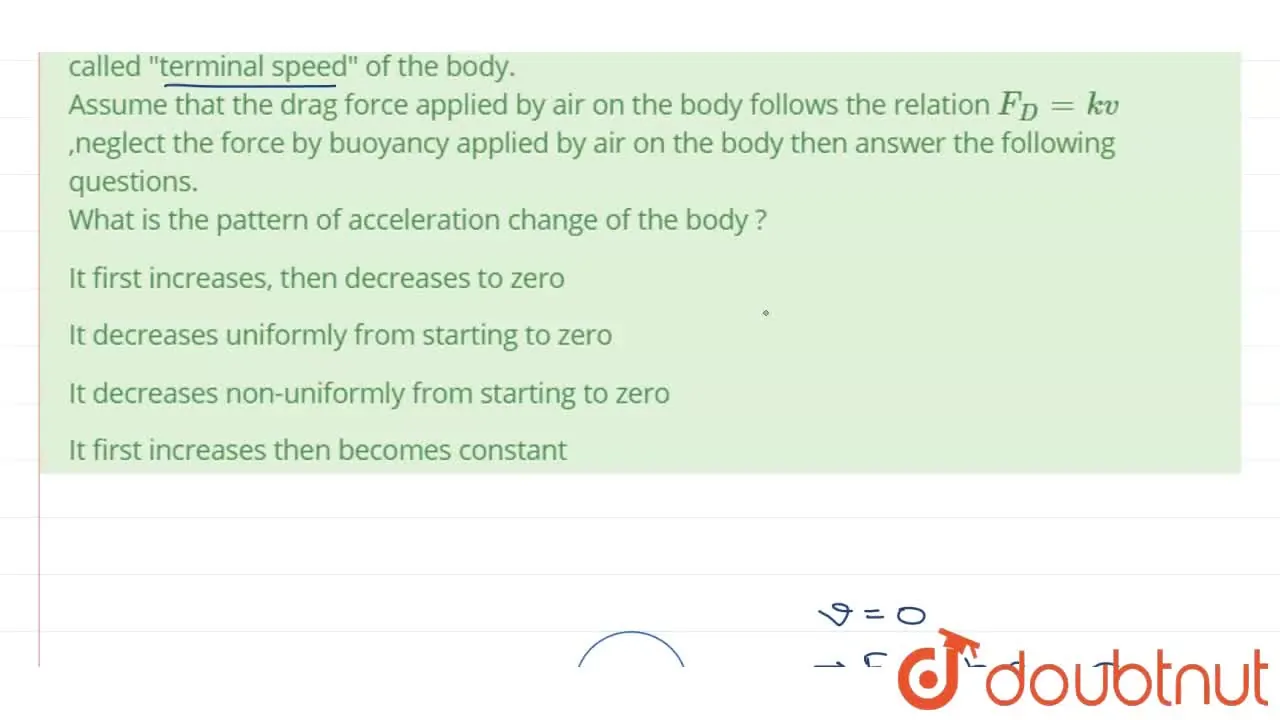If a body moves through a liquid or a gas then the fluid applies a force on the body which is called drag force. Direction of the drag force is always opposite to the motion of the body relative to the fluid. At low speeds of the body, drag frog (FP) is directly proportional to the speed.
FD=kv
What K is a proportionally constant and it depends upon the dimension of the body moving in air at relatively high speeds, the drag force applied by air an the body is proportional to v2
Where this proportionally constant K can be given by
K2ρCA
Where ρ is the density of air
C is another constant givig the drag property of air
A is area of cross-section of the body
Consider a case an object of mass m is released from a height h and it falls under gravity. As it's speed increases the drag force starts increasing on the object. Due to this at some instant, the object attains equilibrium. The speed attained by the body at this instant is called "terminal speed" of the body.
Assume that the drag force applied by air on the body follows the relation FD=kv,neglect the force by buoyancy applied by air on the body then answer the following questions.
What is the pattern of acceleration change of the body ?
It first increases, then decreases to zero
It decreases uniformly from starting to zero
It decreases non-uniformly from starting to zero
It first increases then becomes constant
The correct Answer is:C
Step by step video & image solution for If a body moves through a liquid or a gas then the fluid applies a force on the body which is called drag force. Direction of the drag force is always opposite to the motion of the body relative to the fluid. At low speeds of the body, drag frog ( F _(P)) is directly proportional to the speed. F_(D) = kv What K is a proportionally constant and it depends upon the dimension of the body moving in air at relatively high speeds, the drag force applied by air an the body is proportional to v^(2) Where this proportionally constant K can be given by K_(2) rho CA Where rho is the density of air C is another constant givig the drag property of air A is area of cross-section of the body Consider a case an object of mass m is released from a height h and it falls under gravity. As it's speed increases the drag force starts increasing on the object. Due to this at some instant, the object attains equilibrium. The speed attained by the body at this instant is called "terminal speed" of the body. Assume that the drag force applied by air on the body follows the relation F_(D) = kv,neglect the force by buoyancy applied by air on the body then answer the following questions. What is the pattern of acceleration change of the body ? by Physics experts to help you in doubts & scoring excellent marks in Class 12 exams.
Similar Questions
If a body moves through a liquid or a gas then the fluid applies a force on the body which is called drag force. Direction of the drag force is always opposite to the motion of the body relative to the fluid. At low speeds of the body, drag frog (FP) is directly proportional to the speed.
FD=kv
What K is a proportionally constant and it depends upon the dimension of the body moving in air at relatively high speeds, the drag force applied by air an the body is proportional to v2
Where this proportionally constant K can be given by
K2ρCA
Where ρ is the density of air
C is another constant givig the drag property of air
A is area of cross-section of the body
Consider a case an object of mass m is released from a height h and it falls under gravity. As it's speed increases the drag force starts increasing on the object. Due to this at some instant, the object attains equilibrium. The speed attained by the body at this instant is called "terminal speed" of the body.
Assume that the drag force applied by air on the body follows the relation FD=kv,neglect the force by buoyancy applied by air on the body then answer the following questions.
What is the terminal speed of the object ?View SolutionViscous drag force depends on
View SolutionViscous drag force depends on
View SolutionOn applying force to the centre of mass of a body one of the following is present in the body?
View SolutionThe force that resists the motion of a body on a surface
View SolutionA : Work done by friction can increase the kinetic energy of the body.
R : Friction is a type of contact force and it always opposes the relative motion or tendency of relative motion.View SolutionThe viscous drag on a spherical body moving with a speed v is proportional to
View SolutionAssertion : The force of tension on a body always act away from the body.
Reason: Friction force always opposes the motion of a body.View SolutionWhen a force is applied on an object and if the body moves in the direction of applied force, work is said to be done.
View SolutionAssertion: Frictional force is the component of contact force parallel to the surface.
Reason: Friction force always opposes the motion of a body.View Solution


